Simply scroll through the page or click one of the links below to learn about this artwork.
• THE ONES YOU LOVE MOST
• WE ARE THEM AND THEY ARE US
• ARCHITECTURAL INSPIRATION
Above image includes a framed rendering for illustration purposes only. Please contact your art consultant for specific framing options.
An homage to friendship
Army Signal Corps’ “Fort Fox,” Hollywood, c. 1944. Dr. Seuss second from right, Lee Katz far left.
Friendships often have a profound impact on our lives. Ted Geisel’s friendships played a pivotal role in nearly every facet of his personal and professional development throughout his 70-year career. Lee Katz, a lifelong friend of Ted’s, was no exception. The two originally met while serving in Frank Capra’s “Army Signal Corps” during World War II. Their tight bond became the foundation for an enduring friendship, with both men ultimately living in California and socializing together often.
“Archbishop Katz, as well as Ted’s painting Joseph Katz, appear as likely Seussian homages to his lifelong friendship with Lee Katz.”
The ones you love most
Archbishop Katz in His Cathedral not only seems an homage to this valued relationship, it also becomes a tribute to the importance of friendships in our own lives. Those closest to us are the ones with whom we feel most comfortable, they are the ones we joke with most easily, and the ones to whom we bestow nicknames or other signs of affection.
Here, Ted seems to elevate his friend, Lee Katz, beyond other acquaintances through the nickname and title of this piece—“Archbishop Katz.” Ted also appears to employ his lifelong love for practical jokes by juxtaposing his Jewish friend’s last name, “Katz,” with the Christian moniker “Archbishop.” It is both perfectly Seussian in its nonsense and intimate in its illustration of affection for someone so meaningful in his life.
“Those closest to us are the ones with whom we feel most comfortable, they are the ones we joke with most easily, and the ones to whom we bestow nicknames or other signs of affection.”
Serigraph on Acid-Free Canvas, 24.75" x 36"
Limited Edition of 850 Arabic Numbers, 99 Patrons' Collection, 155 Collaborators' Proofs and 5 Hors d'Commerce.
We are them and they are us
In a gesture that seems to further amplify Ted’s thoughts about his close friend Lee Katz, he paints the central figure as a Cat (Seuss’s most iconic character) in one of only a handful of fully-realized Cat paintings.
The idea of using characters to convey people in our lives was a consistent concept throughout Ted’s entire body of work, as Robert Chase, publisher of the Art of Dr. Seuss writes:
“What took root early in Dr. Seuss’s art and remained constant throughout his 70 years of work was the enduring idea that every Seussian character resembles people we know. Ted never meant this as a literal translation, but rather something more profound. He instinctively infused his creatures with real emotions, so much so that we never get lost in wondering if we, or those we know, look like his characters. Instead, his real genius was that we are swept up in feeling like his characters.”
“What took root early in Dr. Seuss’s art and remained constant throughout his 70 years of work was the enduring idea that every Seussian character resembles people we know...”
Architectural Inspiration
Lee Katz’s home for forty years, Villa Narcissa, was a source of great memories for Ted. His first visit to Villa Narcissa was during the summer of 1946. Ted, a New Yorker at the time, vacationed at the home where he spent his time painting the watercolors for the artistically groundbreaking McElligot’s Pool. This vacation solidified Ted’s desire to leave the East Coast for life in California, a move that ultimately had great visual impact on his work.
It was also the environs of Villa Narcissa that likely provided the visual inspiration behind Archbishop Katz in His Cathedral. Lloyd Wright, son of Frank Lloyd Wright, was commissioned to build "Wayfarers Chapel" on a parcel of land next to Villa Narcissa. This now-famous glass chapel was constructed with a myriad of geometric forms, creating a prism of architectual and natural elements intended to symbolize spiritual values and creatively pay homage to California’s majestic redwood trees. The cathedral-like presence of the surrounding redwoods formed the living walls and roof for the structure.
Ted seems to have transformed Wayfarers’ prism of windows, triangles, and redwoods into a stunning tapestry of geometric colors stretching beyond the edges of the canvas for Archbishop Katz in His Cathedral. In February 1984, the nationally syndicated columnist Herb Kupferberg wrote about seeing this artwork at Seuss House and, without knowing Ted’s influences, likened this artwork to a “huge forest of lavender and blue prisms.”








